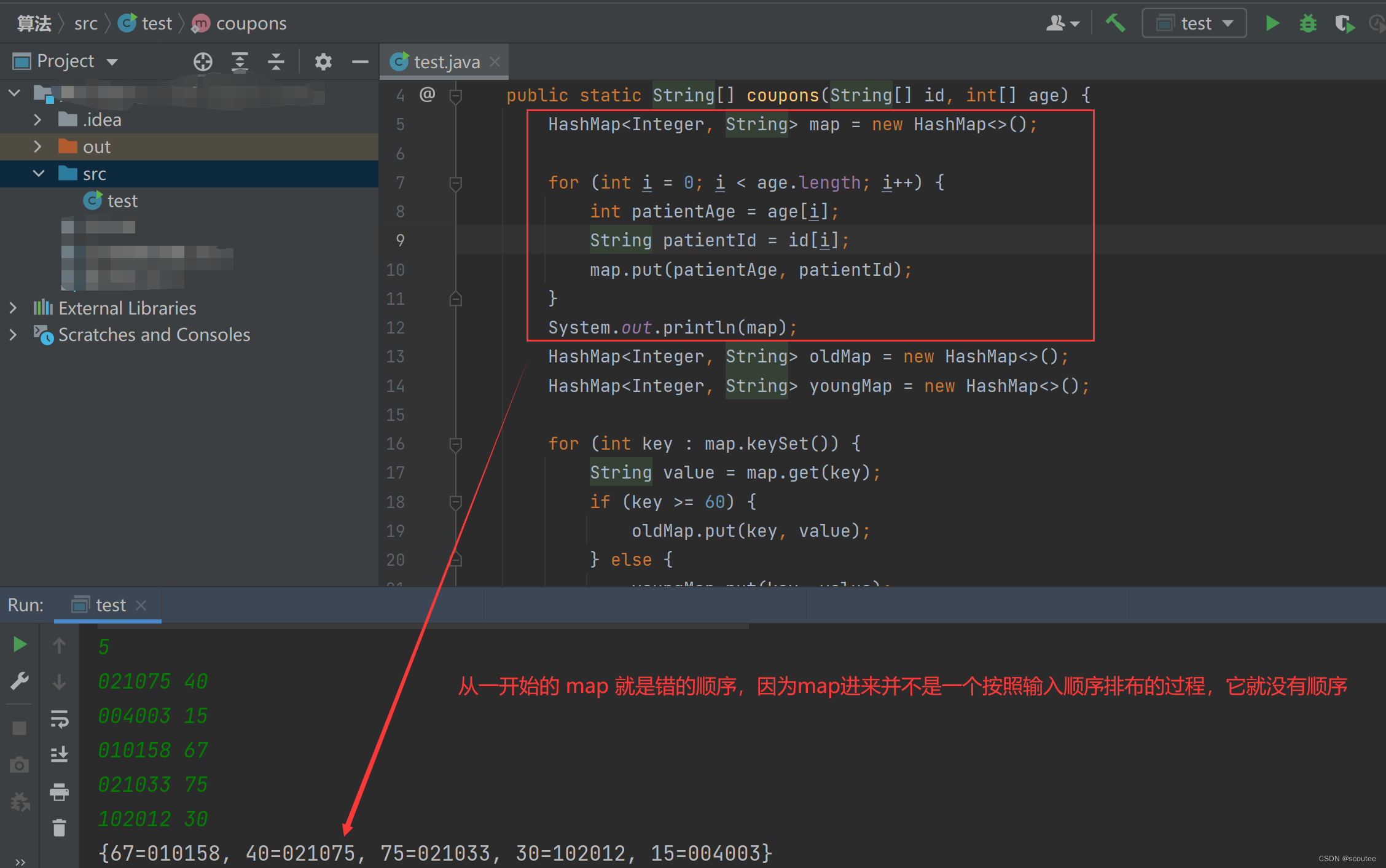【题目】
病人登记看病,编写一个程序,将登记的病人按照以下原则排出看病的先后顺序:
老年人(年龄 >= 60岁)比非老年人优先看病。
老年人按年龄从大到小的顺序看病,年龄相同的按登记的先后顺序排序。
非老年人按登记的先后顺序看病。
【输入格式】
第1行,输入一个小于100的正整数,表示病人的个数;
后面按照病人登记的先后顺序,每行输入一个病人的信息,包括:一个长度小于10的字符串表示病人的ID(每个病人的ID各不相同,且只包含数字和字母),一个整数表示病人的年龄,中间用单个空格隔开。
【输出格式】
按排好的看病顺序输出病人的ID,每行一个。
【样例】
样例输入
5
021075 40
004003 15
010158 67
021033 75
102012 30
样例输出
021033
010158
021075
004003
102012
【思路】
1. 先把输入的数据,按照年龄分成两个 LinkedHashMap,一个是年龄大于等于 60岁 的老年人, 一个是非老年人;
2. 对老年人的 LinkedHashMap按照 年龄大小 进行从大到小排序 ;
3. 非老年人的 LinkedHashMap就按照登记顺序(即在数组中的顺序)输出就可以。
【注意】这里需要考虑到排序的 稳定性问题
排序算法的稳定性是指当存在两个相等的元素时,排序后它们的相对位置是否保持不变。
具体来说,如果在排序前,有两个相等的元素 A 和 B,且 A 出现在 B 的前面,那么如果排序算法是稳定的,经过排序后,A 仍然应该出现在 B 的前面。
稳定性对于某些应用场景非常重要。例如,在按照 老年人的年龄 进行排序的情况下,如果有两个 年龄相同 的老人,他们的顺序可能会影响到他们的排名。如果排序算法是稳定的,相同年龄的老人的 相对顺序 将被保留,而这个相对顺序恰好就是 登记的先后顺序。
【注意】观察题目的输入
Main函数里面的public static String[] sort(String[] id, int[] age){ return id; }
这个函数的输入是 String[] id 和 int[] age的,也就是说题目已经帮我们把 输入的
5
021075 40
004003 15
010158 67
021033 75
102012 30
转换成了分离的
021075
004003
010158
021033
102012
和
40
15
67
75
30
所以我们要建立一下 String[] id 和 int[] age 的映射关系,由于可能会存在老年人年龄相同的情况(Key值相同),所以不用二叉搜索树,而是用 Hashmap 。
【排序算法】
基本的冒泡算法就可以
【踩坑】

所以要用 Map<String,Integer> map = new LinkedHashMap<>();
另外,由于年龄可能存在相同的情况,所以如果把 age 作为 Map 的 Key 值,会存在相同 Key 值的被覆盖的问题,比如说 有 011111 44, 022222 44 ,后面的022222 44 就会把前面的覆盖掉,因为 Key 值只可能是唯一对应的。
【代码】
import java.util.*;public class test {public static String[] coupons(String[] id, int[] age) {
// 错误写法: HashMap<Integer, String> map = new HashMap<>();// 建立一个有序的LinkedHashMap存放所有数据Map<String,Integer> map = new LinkedHashMap<>();for (int i = 0; i < age.length; i++) {map.put(id[i],age[i]);}System.out.println(map);// 把数据分成 老年人 map 和 非老年人 mapMap<String,Integer> oldMap = new LinkedHashMap<>();Map<String,Integer> youngMap = new LinkedHashMap<>();for (String key : map.keySet()) {int value = map.get(key);if (value >= 60) {oldMap.put(key, value);} else {youngMap.put(key, value);}}// 用List把他们包裹起来List<Map.Entry<String,Integer>> sortedOldList = new ArrayList<>(oldMap.entrySet());List<Map.Entry<String,Integer>> youngList = new ArrayList<>(youngMap.entrySet());System.out.println(youngList);// 对老年人进行按照年龄大小的冒泡排序for (int i = 0; i < sortedOldList.size(); i++) {for (int j = 0; j < sortedOldList.size() - 1 - i; j++) {if (sortedOldList.get(j).getValue() < sortedOldList.get(j + 1).getValue()) {Collections.swap(sortedOldList, j, j + 1);}}}// 输出for (int i = 0; i < sortedOldList.size(); i++) {id[i] = sortedOldList.get(i).getKey();}for (int i = sortedOldList.size(); i < (sortedOldList.size() + youngList.size()); i++) {id[i] = youngList.get(i - sortedOldList.size()).getKey();}return id;}// APPEND BEGINpublic static void main(String[] args){Scanner reader = new Scanner(System.in);int n = reader.nextInt();String[] id = new String[n];int[] age = new int[n];int i = 0;while (reader.hasNext()){id[i] = reader.next();age[i++] = reader.nextInt();if (i == age.length) break;}String[] result = coupons(id,age);for (String re : result){System.out.println(re);}}
}









![[RK3568 Android11] 开发之默认授予系统预置的APP权限](http://pic.xiahunao.cn/[RK3568 Android11] 开发之默认授予系统预置的APP权限)

)
)





